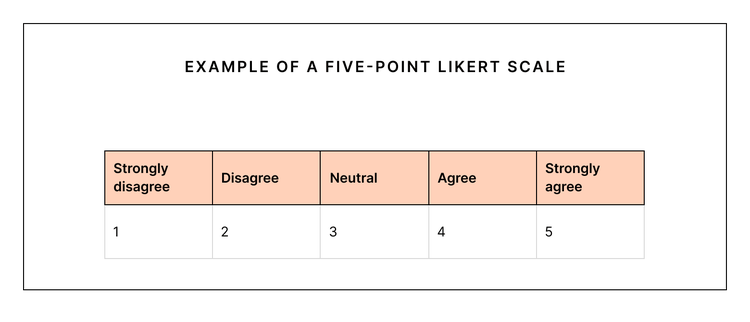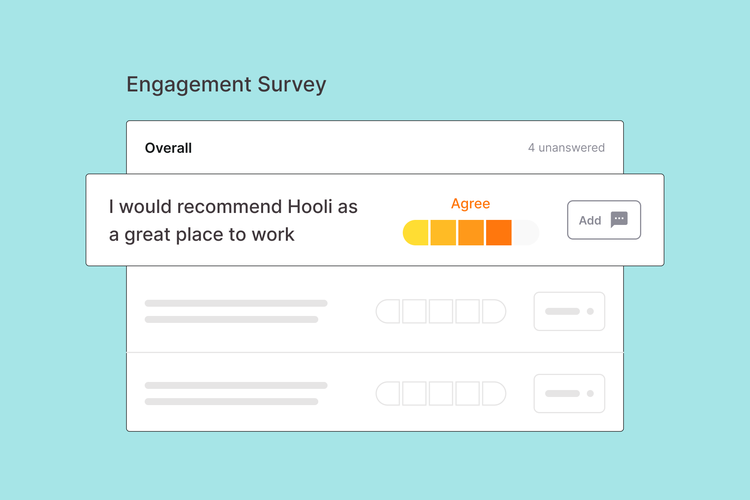
22 employee engagement survey questions you should ask (Updated 2023)

Written by

Senior Data Journalist, Culture Amp
When I asked a friend how they'd define employee engagement, they said, “It’s allowing employees to feel a part of the system. Giving them autonomy.” Another friend shared: “It’s employee happiness. Do people feel good about showing up to work?”
If you were asked to define employee engagement, what would you say?
At Culture Amp, here's how we would define employee engagement:
Employee engagement represents the levels of enthusiasm and connection employees have with their organization. It's a measure of how motivated people are to put in extra effort for their organization and a sign of how committed they are to staying there. Importantly, employee engagement is an outcome that depends on the actions of their organization, driven by leadership, managers, and people teams.
So, how do we understand if employees are engaged at their organizations? That's why many of today's top HR and People leaders are asking.
In this article, you’ll learn:
- Why it’s important to measure employee engagement (and how to get started)
- How to get the most out of your engagement survey
- The 22 best survey questions to measure and understand employee engagement
- An easy-to-reference benchmark visualization for each of the questions
- Why the question scale of an employee engagement survey matters
Why measure employee engagement?
By measuring employee engagement, you can:
- Improve key business outcomes. Studies have found that companies with high engagement scores also experience higher performance, business performance, and innovation.
- Collect feedback at scale. Employee engagement surveys enable teams to collect data on employee sentiment across the organization, empowering them with the right data – the data representing the collective voices of your employee base rather than the loudest voices of a few people.
- Take informed action on improving company culture or people's experiences at work. If you’re not providing a way for people to provide feedback internally, you’re missing out on the opportunity to agilely improve your employee experience and company reputation. For example, many people may take to social media or public review sites like Glassdoor to voice their opinions of the company – but only once they exit the company.
- Understand areas of improvement. Employee feedback collected through engagement surveys will help you flag areas of improvement before they become detrimental to productivity and company culture. With a regular cadence of surveys, you’ll also learn more about what’s motivating people to go above and beyond at your company and why they're choosing to stay.
As you can see, conducting an employee engagement survey is highly beneficial. Such surveys are key for collecting the data and surfacing the insights you need to make strategic decisions and understand your employees.
How to get the most out of your employee engagement surveys
It’s not enough to just conduct an engagement survey – you need to conduct the engagement survey effectively. Below, we share several best practices and resources to help you make the most of your employee engagement survey:
- Effectively communicate about the survey. Communicating the “what, why, how, and when” of your employee engagement is essential for encouraging employees to not only participate but also to provide open and honest feedback.
- Be cognizant of survey length. Be considerate of your employees’ busy schedules. In our experience, surveys should take no longer than 10 minutes to complete. Any longer, and employees may “rush” to complete the survey, giving you either inaccurate or incomplete answers.
- Only ask questions you feel prepared to take action on. If you want your employees to share candid feedback about the employee experience, you need to be prepared to take action on that feedback. People expect their feedback to lead to tangible changes – otherwise, what’s the point of sharing the feedback in the first place? As our CEO and co-founder, Didier Elzinga, says, “The most typical reason people don’t want to fill out your survey is that you haven’t done anything since the last one. They don’t have survey fatigue – they have lack-of-action fatigue.”
- Mobilize managers. Managers are usually the people whom employees have the most one-on-one time with. As a result, they are also the people who are best positioned to communicate the importance of taking the survey.
- Run your survey multiple times. A one-time survey won’t offer insight into how your people strategy is or isn’t working. In order to see how your company’s actions impact your employees’ experience, you should run surveys more than once to establish a baseline, thereby allowing you to see how employee perceptions change over time.
Last but not least, you need to ask the right questions in your survey. In any employee engagement survey, we encourage a balanced mix of validated questions (like the ones we’ve provided below) and unique questions relevant to your organization's specific context. The more you survey your employees over time, the more you’ll be able to see which questions provide you with the best insights for action.
Curious about which questions to ask? In the next section, we identify the best engagement questions and interpret what the results of these questions mean for your organization.
Let’s dive in.
The 22 best employee engagement survey questions
We launched Culture Amp to help build a better world of work. Our team of organizational psychologists, data scientists, and engineers keeps our platform up-to-date with academic findings, feedback, and learnings from our clients. Our employee engagement questions (also known as staff engagement questions) have been used in surveys by 6000+ culture first companies. We pull this data together yearly to bolster our benchmark research and to identify employee engagement trends.
We have identified our employee engagement survey items from external research and validated them through external metrics, like Glassdoor ratings and Mattermark Growth scores.
To understand what a typically “normal” score across companies and industries is, we provide benchmark scores to give context on what is “high” and “low” scores for organizations of all of these items.
Without further ado, here are the top 22 employee engagement survey question examples you should ask on your next survey. They're divided into four main types: employee engagement index, LEAD, company confidence, and free-text questions.
Employee engagement index questions
Employee engagement index questions
These first five survey questions represent our “engagement index.” We believe that understanding employee engagement takes more than one question. Our index combines questions that focus on the following key outcomes of employee engagement:
- Pride
- Recommendation
- Present commitment
- Future commitment
- Motivation
We measure these outcomes using the following five questions:
1. “I am proud to work for [Company]”
This question is colloquially called the “barbecue test” – as in, would an employee be proud to tell someone where they worked if asked at a barbecue? Scores on this question reflect levels of brand and mission affiliation and can give you insight into how your external brand is viewed by people internally.
The benchmark range for this question (falling between the 40th and 60th percentiles of our data) is 84% - 88% agreement. A low score, defined as the bottom quartile percentile, is at or below 79. This is a red flag that there may be internal concerns about your brand.
⭐ If your organization’s score is 91% or higher, you would be in the top quarter percentile, showing that your employees are more proud of where they work than 75% of organizations.
2. “I would recommend [Company] as a great place to work”
This is our version of the Employee Net Promoter Score question. The eNPS was launched in 2003, and some companies use it as their sole indicator of employee engagement. However, we believe it’s not robust enough of a stand-alone measure. For instance, people might recommend your company but are planning to leave. Likewise, they might be unsatisfied with their role but would still recommend your company because of high pay or desirable perks.
Our benchmark range for this question is between 80 - 85%, indicating people generally enjoy the experience of working at their company. Scores 75% or lower (in the bottom quarter percentile) may point toward day-to-day discontent or overall issues with the workplace environment.
⭐ Scores at or above 89% are considered to be high, in the top quarter percentile.
3. “I rarely think about looking for a job at another company”
This question gets at an employee's present commitment to your company. It's sometimes a nice reality check for companies with high scores on the other engagement index questions. People who are engaged at work often find that looking for a job elsewhere hasn’t crossed their minds.
Due to the nature of this question, it has a benchmark range of 54% - 60% . 65% and above would be considered a very high score, in the top quarter percentile. A score at or below 50% is a strong indicator of turnover. For this question in particular, we recommend looking for variation across demographics (i.e., are women less committed to your organization than men?).
4. “I see myself still working at [company] in two years’ time”
This question also measures commitment, but with a specific time frame. An employee who isn't currently looking for a job at another company isn't necessarily an employee who intends to stay for another two years. Questions 3 and 4 give us a whole picture of present and future commitment, which we use to calculate an overall retention index.
📏 Benchmark responses for this question are in the 64 - 69% range. If your score is higher on this question than on the above, you can somewhat discount concerns about retention. However, these two questions tend to move together and are usually a fair measure of retention.
⚠️ If you scored 59% or lower, you’re in the bottom 25% of organizations.
⭐If you scored 74% or higher, you’re in the top 25% of organizations.
5. “[Company] motivates me to go beyond what I would in a similar role elsewhere”
This question measures discretionary effort and assesses whether your company motivates people to do their very best. In industries where tenure is traditionally low, this question is particularly important. For example, this would be a key question for a seasonal workforce in which low scores for “I see myself still working at [this company] in two years’ time” would not raise any concerns.
The global benchmark responses are typically in the 67 - 73% range. Scores 62% and below (bottom 25% percentile) may indicate that people feel disconnected from the company mission or don’t feel enabled to get things done. Scores at or above 78% (top 25% percentile) are considered high.
Questions about leadership, enablement, alignment, and development (LEAD)
After our engagement index, we ask questions about the four main factors that drive employee engagement (LEAD):

Questions about leadership
6. “The leaders at [company] keep people informed about what is happening”
Communication is critical for establishing any level of engagement within a company. Informing people about what is happening builds a foundation for communication from leadership at the most basic level.
As organizations continue becoming less hierarchical, scores for this question should go up. As it stands, our benchmark for this question is in the range of 69% - 75% . If your company’s level of agreement with this question falls at or below 63% (bottom quarter percentile) , you should take a closer look at your communication strategies for areas of improvement. If your organization scores at or above 81% (top 25% percentile), you’re doing really well. We’d encourage you to keep how you’re informing your employees.
7. “My manager is a great role model for employees”
Rather than asking specifically about the relationship between a manager and their direct report, this question examines how people see their manager within the broader context of the company.
The benchmark for this question is in the 80 - 84% range, with low scores (bottom quarter percentile) at 77% and below, indicating that additional resources (e.g., trainings, learning modules, etc.) for your managers may be necessary. Increasing to a high score like 87% (top quarter percentile) will require identifying what is currently being offered and improving how you upskill your managers to motivate employees.
8. “The leaders at [Company] have communicated a vision that motivates me”
For this higher-level statement to be accurate, people need to first feel informed about what is happening at the company (as reflected in question six). Only then will they feel motivated by or connected to something "bigger" than their day-to-day work. Driving motivation is crucial for increasing employee engagement.
Benchmarks for this question are in the 65%-72% range. As discussed above, scores are often impacted by how informed people feel. If scores for both feeling informed (question 6) and feeling motivated (this question) are low (59% or lower for the bottom 25th percentile), focus first on improving communication with your employees. From there, you can work on improving motivation.
⭐ If your score is at or above 78%, you’re in the top quarter percentile of organizations. Your leaders are doing a good job of communicating their vision for the company.
Questions about enablement
9. “I have access to the things I need to do my job well”
This question is pretty self-explanatory: Do people have what they need to do their work and develop? This is a crucial hygiene factor, meaning you can’t move forward without this. It's good to note that we've intentionally used the broader word “things” here rather than “resources” or “tools.”
Benchmark scores for this question are in the 76%-80% range. Scores at or below 72% (bottom quartile) indicate that you should look into what people lack when it comes to doing their job. This is where looking at free-text responses associated with the question can be beneficial.
⭐If you score 84% or higher on this item or the next, you’re an enablement rockstar.
10. “I have access to the learning and development I need to do my job well”
This question goes deeper than the previous question. Put simply: Are learning and development opportunities (like training and information, coaching, intellectual and emotional support) available to people? In our modern workplace, people need more than the right resources. They also need access to the right experiences to learn and grow. How people respond to this question is important, as learning and development is a consistent driver of employee engagement across industries.
Benchmark scores for this question are in the 71% - 76% range. Low scores, at or below 66%, indicate an opportunity to improve your learning and development opportunities, whereas high scores (80%+) show that you’re doing well here.
11. “Most of the systems and processes here support us getting our work done effectively”
We’re intentionally avoiding using absolutes in this question, opting for "most" instead of "all." Even the greatest company will struggle to achieve a state where all systems and processes work perfectly. This question asks: On top of the things people need to get work done (question 9) and the learning and development opportunities needed for people to succeed (question 10), does a company-wide infrastructure exist that can enable all of this to happen?
Because of the relative difficulty of achieving effective systems and processes, the benchmark range for this question is 61 - 68%. Falling at 55% or below clearly indicates that you’re in the bottom quartile of organizations. You should reevaluate your company’s systems and processes and have an opportunity to invest in new infrastructure support.
⭐ Scoring 74% or above means you’re doing better than 75% of organizations.
Questions about alignment
12. “I know what I need to do to be successful in my role”
People need to know what they must do to be personally successful. This basic level of understanding needs to be implemented before people can further develop their alignment with the company.
Benchmarks for this question are generally in the range of 85 - 88%. Lower scores, 83% and below, can signal misalignment or misunderstanding about how success is defined in each role. Note that this question can vary based on a person’s team or tenure with your company.
⭐ High scores for this are above 90% (top quarter percentile).
13. “I receive appropriate recognition when I do good work”
Once people know what they need to do to be successful, they should be appropriately recognized for their achievements. If people don't get any recognition for making progress, it's hard for them to stay motivated.
Like in the alignment section, scores for this question can be influenced by how people feel about the previous question. Recognition is also a more challenging target for companies to reach, which is reflected in the benchmark falling around 68% - 73%. Scores of 64% or below show that employees do not feel recognized for their work. If this is the case at your company, encourage managers and leaders to shout out their teams’ accomplishments and educate on the importance of asking their reports how they prefer to receive recognition.
⭐ Scores at or above 77% mean that your organization is appropriately recognizing good work.
14. “Day-to-day decisions here demonstrate that quality and improvement are top priorities”
When we initially wrote this question, we visualized engineering teams, but over time, we've found these values to ring true across departments and roles.
We know that this question is among the top drivers of engagement. This is especially true for high-performing, financially successful companies. The benchmark for this question is 65 - 71%. If you’re falling below this range, especially in the bottom quartile percentile (59% or below), consider holding employee focus groups to dig deeper into why the company's day-to-day decisions are falling short.
⭐ If you fall at or above 77% (top quarter percentile), keep up your efforts to prioritize quality and improvement.
Questions about development
15. “My manager (or someone in management) has shown a genuine interest in my career aspirations”
This question examines the one-on-one level interactions that build the foundation for people to feel like they can develop at the company down the line. It’s great when managers have the technical competence and can share those skills with their team, but employee development is arguably more important for any employee's success. For that reason, it's important for managers to focus on development during 1-on-1 meetings.
The benchmark for this question is in the 71 - 76% range. If your score for this question is at or below 66%, your managers are falling short of developing their team members – an essential part of their roles. Your organization should clearly communicate this as an expectation of managers. Scores at or above 79% are in the top 25% of organizations.
Pay close attention to this question, as development is important for driving motivation, engagement, and retention. Our people scientists have found that when people believe good career opportunities are available to them, they’re more engaged at work. We try to avoid words like “upwards” or “advancement” – which connote a higher level. The “right” opportunity may constitute a lateral move to a different department at the same level. This language is essential in less hierarchical organizations.
16. “I believe there are good career opportunities for me at this company”
We see the scores for this question in the 62 - 68% range in our benchmark. Falling below this range can signify that people’s perceptions of career opportunities are lower than the average organization.
Scoring at or below 57% means that you’re in the bottom quarter of organizations. If this is the case, you should definitely ramp up your efforts to make career opportunities available and communicate that accordingly.
Scoring at or above 73% means that you’re in the top quarter percentile, so this is not an issue for your organization.
17. “This is a great company for me to make a contribution to my development”
This question was inspired by author Dan Pink’s idea of mastery. It asks: Does the company contribute to your development in your craft or industry?
This question is frequently one of the top drivers of engagement, and the benchmark range is 74% - 79%. Since development is a huge driver of engagement, you should prioritize taking action on low scores for this question, at or below 69% (bottom quarter percentile). Find out why people don’t feel the company contributes to their larger development, make changes based on their feedback, and communicate these changes to your people.
⭐Scoring at or above 84% signals the fact that employees perceive your company as a great place to develop (in the top 25% of organizations).
Questions about overall company confidence
Last but not least, we often include two items to gauge employees’ confidence in their organizations on the whole.
18. “Our company effectively directs resources (funding, people, and effort) towards company goals”
We find that employees who are confident that their organizations are appropriately directing resources are more likely to be engaged. This makes sense, as you wouldn’t want to invest your time and energy into an organization that isn’t using its resources wisely.
This question is especially important to ask for organizations that are going through significant changes and/or are offering new products in the market.
Our benchmark range for this item is between 58% - 65%. If you score at or below 51% (bottom quartile of organizations), we would advise you to take a closer look at how your resourcing aligns with your goals and how you are communicating this alignment with your employees. If you score at or above 72% (top quartile of organizations), your employees, by and large, believe that your organization is using resources to move forward.
19. “My company is in a position to really succeed over the next three years”
Not only is it important for employees to believe that the organization is using its resources well, but they also need to see a future in which the organization is succeeding. Why invest in working at a company where the rewards of your labor won’t pan out in the longer term?
Our benchmark range for this question is between 72% - 80%. Organizations in the bottom quartile score at or below 65%. If this includes your organization, we recommend that your leadership clearly articulate their three-year plan to employees. If you’re scoring at or above 85%, your organization is in the top quarter percentile. It’s clear that your employees can see a path toward long-term success at your company.
Free-text and open-response questions
- 20. “Are there some things we are doing great here?”
- 21. “Are there some things we are not doing so great here?”
- 22. “Is there something else you think we should have asked you in this survey?”
For all the questions above, you’re looking to solicit open-ended feedback and allow people to provide general comments. Responses to these questions tend to focus on tangible things (like workplace environment), but employees may also give you feedback on leadership, development, and more. If many people feel that the survey doesn't address a particular topic of interest, you can consider including new questions focused on that topic in the future.
The value of free-text questions is that they provide qualitative data to complement the quantitative data from the scale-based questions. However, you can also provide an optional area for employees to add open-ended feedback in scale-based questions.
Benchmarks for each of the engagement questions
Below, we've compiled benchmark ranges for each of the engagement items above for easy reference. While these numbers are useful frames of reference, for optimal insight, we recommend using benchmarks that compare your company to companies similar to yours (i.e., same industry, company size, etc.)
Why the question scale matters in an engagement survey
For all of our questions (except free-text-only responses), we use a 5-point Likert scale that measures agreement to a statement. You might be asking, “Why five? Why not seven? Why not eleven?!”
Good question.
There is ample academic research that debates the pros and cons of various different point scales. We’ve found that a 5-point scale encourages survey participation (fewer choices means it’s faster to complete) and gathers the right amount of detail. A more detailed scale could add more nuance to your survey results, but we’ve found that it’s sometimes an unnecessary amount of detail. A consistent, 5-point Likert scale is simple and suits the needs of our people geeks.

How our Likert scale response works
For example, the survey-taker is presented with the statement: “I am proud to work for ACME”
They then choose from a scale of agreement with the following options:
- Strongly Disagree
- Disagree
- Neither Agree nor Disagree
- Agree
- Strongly Agree
Using a consistent Likert scale throughout the employee engagement survey will allow people to answer questions more easily. The familiarity of the scale removes some of the stress associated with answering survey questions. We also think it’s important to have levels of agreement rather than just a number-based scale, as different people will interpret a 1-5 numerical scale differently. To further reduce ambiguity, our questions are all phrased to identify the ideal state (for example, again, “I am proud to work for ACME”).
In addition to the Likert scale, each question has a field to collect open-text responses. We encourage this for all employee surveys, not just your annual or bi-annual engagement survey because it allows you to tap into quantitative and qualitative employee feedback. As you can see below, Culture Amp's employee engagement tool not only leverages the Likert scale but also allows employees to optionally add their own comments.

Start crafting your employee engagement survey
Collecting employee feedback is the best way to start shaping your company’s culture. Listening to the voices of your people, and then sharing with them what you’ve learned and how you’ll move forward together is a cornerstone of what it means to be a great company today.

Ready to take your survey experience to the next level?
Request a demo of our Employee Engagement Platform for access to ready-to-use surveys, organizational insights, and more.”
Updated December 12, 2023 with our global benchmarks from July 2023. Originally published on November 10, 201




